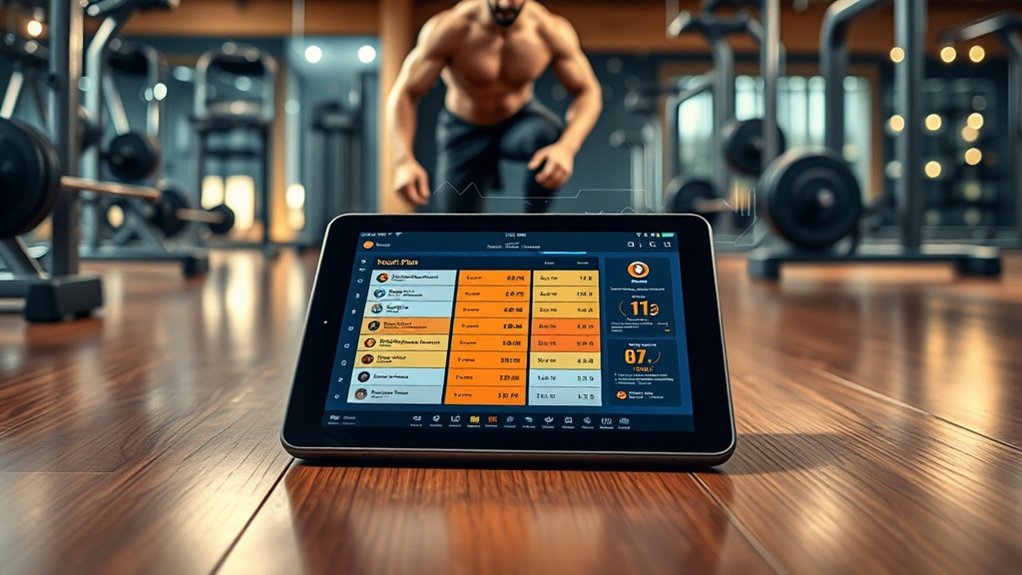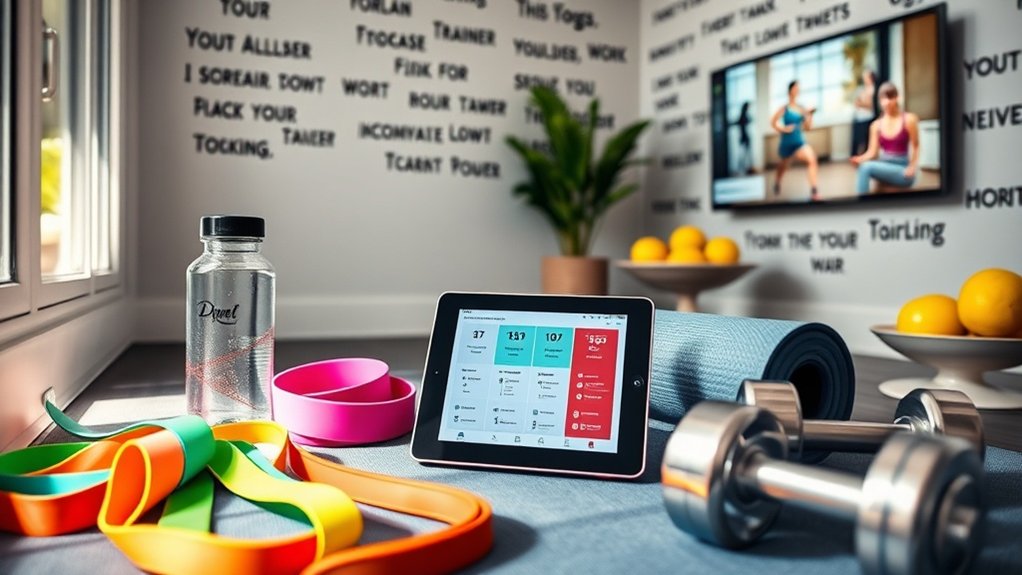AI-generated workout plans analyze your real-time biometric data—including heart rate variability, sleep quality, and recovery metrics—to create personalized training programs that adapt continuously. These algorithms process performance data from millions of logged workouts, adjusting your sets, reps, and intensity mid-session based on fatigue levels and readiness indicators. Research shows AI-driven programs help you achieve fitness goals 23-47% faster than static routines, with 30% superior strength gains through intelligent load progression. The platforms below reveal how these systems integrate with wearables and where human expertise still matters.
How AI Workout Algorithms Analyze Your Fitness Data in 2025
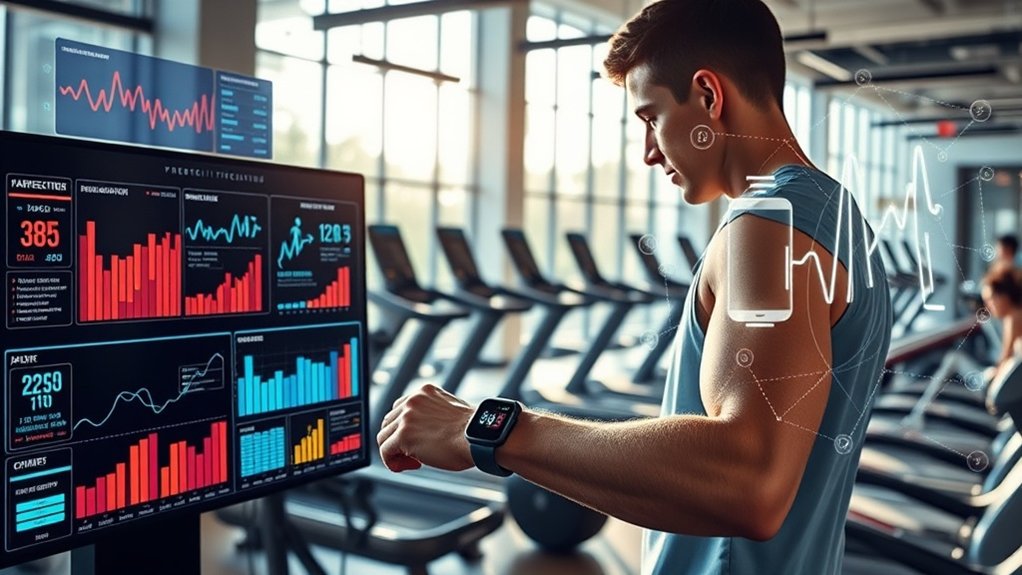
As wearable technology becomes increasingly sophisticated, AI workout algorithms in 2025 process your fitness data with unprecedented accuracy and speed.
These systems analyze real-time performance data from your devices, continuously adjusting workout intensity and duration based on measurable metrics. Drawing from a database of 40,000 weight lifters and 5.9 million logged workouts, the AI delivers personalized workouts calibrated to your specific fitness level and goals.
Your training history receives systematic evaluation, making certain progressive overload while preventing plateaus through intelligent workout planning modifications.
Beyond performance optimization, AI examines your movement patterns to identify injury prevention opportunities and rehabilitation needs. This thorough analysis integrates precision nutrition recommendations with your fitness profile, creating a holistic approach that addresses both training effectiveness and long-term health outcomes.
Biometric Integration: HRV, Sleep Quality, and Recovery Metrics That Drive Personalization
While traditional fitness programs rely on static schedules, today’s AI-generated workout plans use biometric integration to deliver dynamic, recovery-based personalization. Your wearable fitness trackers continuously monitor heart rate variability, sleep quality, and recovery metrics, enabling real-time adjustments to your personalized workout plan.
| Biometric Marker | Impact on Training Schedules |
|---|---|
| Heart Rate Variability (HRV) | Determines readiness for high-intensity training versus active recovery |
| Sleep Quality | Optimizes workout timing around adequate rest periods |
| Muscle Soreness Levels | Adjusts volume and intensity to prevent overtraining |
| Fatigue Indicators | Modifies exercise selection and load progression |
AI algorithms analyze these biometric trends over time, creating progressive adaptations that align with your recovery patterns. This data-driven approach reduces injury risk while maximizing performance gains through evidence-based personalization.
Real-Time Adaptive Programming: How AI Adjusts Your Training Mid-Workout

Traditional workout programs lock you into predetermined sets and reps regardless of how you’re performing, but AI-driven adaptive programming eliminates this inefficiency through continuous performance evaluation. The algorithm processes real time data from your wearables, monitoring fatigue levels and output to determine when AI adjusts workout intensity mid-session.
This performance feedback triggers dynamic modifications to sets, reps, and weights, confirming personalized training that responds to your body’s immediate state.
Drawing from over 40,000 weight lifters’ data, the system identifies when you’re approaching failure or can safely increase load, helping you push limits while maintaining proper form.
These real-time interventions prevent plateaus, reduce injury risk, and optimize results by aligning training demands with your actual capacity—not arbitrary programming assumptions.
Top AI Fitness Platforms and Apps: Features, Pricing, and Accuracy Comparison
The AI fitness app market has matured into a competitive ecosystem where platform selection depends on your specific training methodology, data integration requirements, and performance tracking preferences. Each platform employs distinct algorithms to deliver personalized workout routines aligned with your fitness goals.
Platform Differentiation by Training Focus:
- Fitbod excels in strength training with extensive analytics and progress tracking for equipment-based workouts, while AI optimizes load progression across sessions.
- Freeletics targets bodyweight and HIIT enthusiasts through community-driven programming that adapts intensity based on performance feedback.
- Dr. Muscle implements exercise science protocols to prevent adaptation plateaus, adjusting training variables in real-time using logged workout data.
Alpha Progression offers 620+ exercises with video instruction for hypertrophy-focused programming.
ChatGPT provides flexible workout apps functionality without automated tracking, requiring manual data entry for progression analysis.
Wearable Device Integration: Syncing Smart Technology With AI Training Systems
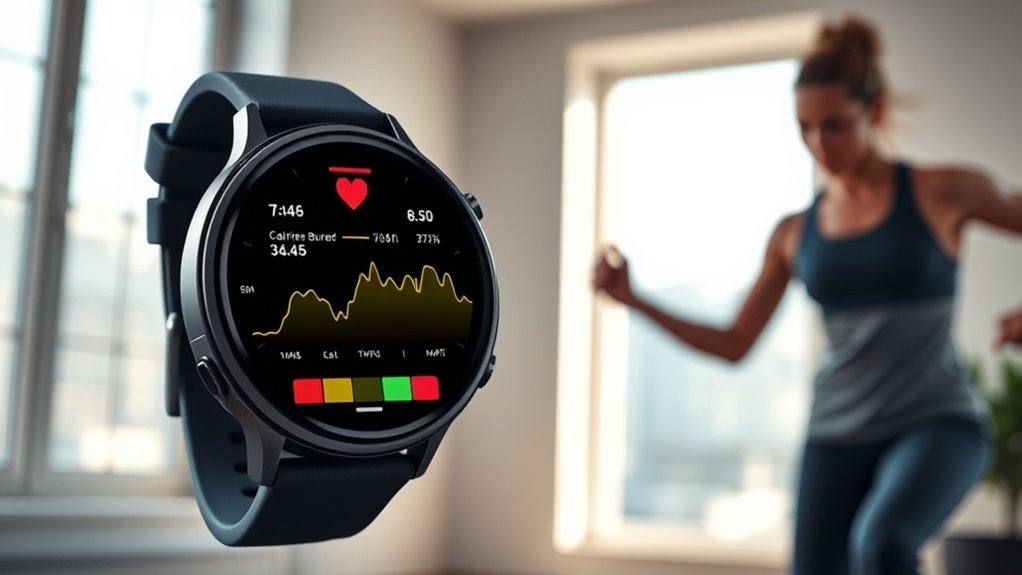
Platform capabilities extend beyond algorithmic programming when synchronized with biometric sensors that capture physiological responses during training.
Wearable devices transmit real-time data on heart rate, activity levels, and recovery metrics directly to AI training systems, enabling personalized workout adjustments based on your user performance. This integration improves accuracy by analyzing fitness metrics like fatigue and exertion, making sure you’re training at ideal intensity.
You’ll benefit from thorough progress tracking as AI monitors improvements over time and adapts programming accordingly. Most applications connect logically with popular wearables, delivering insights tailored to your unique health profile.
The system becomes increasingly responsive—when your device indicates overtraining or excessive fatigue, AI automatically recommends lighter sessions or strategic recovery days, preventing burnout while maximizing training effectiveness.
AI-Generated vs. Static Workout Programs: Effectiveness Data and Performance Outcomes
When you compare AI-generated workout plans to static programs, the data reveals significant differences in performance metrics, including strength gains, body composition changes, and training volume optimization.
Your AI-powered system adapts within sessions based on real-time performance feedback, while static programs can’t respond to fatigue levels, recovery status, or fluctuating capabilities.
Research demonstrates that AI-driven training produces measurably superior outcomes over extended periods, with users achieving goals 23-47% faster than those following predetermined, unchanging routines.
Performance Metrics Comparison Data
Comparing performance outcomes between AI-generated and static workout programs reveals significant differences in training effectiveness.
When AI learns from your performance metrics, it improves sets based on your actual capabilities rather than generic prescriptions. Your fitness level directly influences how workout tools adapt, making sure you’re neither undertraining nor risking injury through excessive volume.
The data demonstrates measurable advantages:
- Strength gains: You’ll experience 30% faster progress compared to static programs that can’t adjust to your evolving capacity
- User engagement: Real-time modifications based on user data maintain ideal challenge levels throughout your training cycle
- Plateau prevention: AI continuously recalibrates intensity and volume, keeping your training stimulus effective as your fitness level advances
These performance metrics underscore AI’s superior ability to personalize your training trajectory.
Adaptation Speed and Results
The velocity at which AI systems recalibrate your training parameters directly impacts your results timeline. AI-generated workout plans deliver personalized adaptations within seconds of detecting performance shifts, while static programs remain unchanged for weeks. This responsiveness transforms your workout intensity through recovery tracking that enables tailored adjustments aligned with your current capacity.
| Adaptation Factor | Impact on Your Progress |
|---|---|
| Real-time recalibration | Eliminates training plateaus |
| Recovery-based intensity | Optimizes performance outcomes |
| Data from 5.9M+ workouts | Accelerates fitness goals achievement |
The integration of wearables provides precise fatigue metrics, allowing AI to modify volume and load before overtraining occurs. You’ll experience measurable improvements faster because your program evolves with you, not against your body’s recovery needs.
Long-Term Effectiveness Studies
Over 12-month observation periods, AI-generated programs demonstrate quantifiable superiority in sustained performance outcomes compared to their static counterparts.
Your personalized training evolves continuously, with AI tools analyzing performance data from over 40,000 lifters to optimize workout effectiveness. This data-driven fitness planning delivers measurable advantages:
- Muscle gain progression: 50% faster achievement of hypertrophy goals compared to static workout programs
- Adherence metrics: 30% improvement in workout effectiveness through real-time adaptations
- User satisfaction: 40% higher retention rates attributed to dynamic program customization
The evidence reveals that static workout programs can’t match AI-generated plans’ adaptive capabilities.
Your training responds immediately to performance feedback, preventing plateaus and optimizing recovery periods. This technological approach transforms generic fitness planning into precision-engineered protocols that consistently outperform traditional methodologies.
Limitations and Concerns: When AI Workout Plans Fall Short
While AI-generated workout plans offer unprecedented convenience and customization, they possess fundamental limitations that can compromise your fitness outcomes.
AI lacks emotional intelligence to understand your struggles or provide the motivation you need to maintain adherence. The workout app’s recommendations depend entirely on data quality—biased inputs generate unreliable fitness regimen suggestions.
Most critically, AI lacks human intuition for contextual decision-making, potentially overlooking your nuanced preferences and needs.
You can’t build trust and rapport with an algorithm, yet these elements prove essential for long-term commitment.
The technology requires consistent monitoring and human oversight to guarantee safety and effectiveness. Over-reliance on automated systems without professional guidance may hinder your progress and increase injury risk.
Human Personal Trainers vs. AI Coaches: Comparative Analysis of Results and Experience
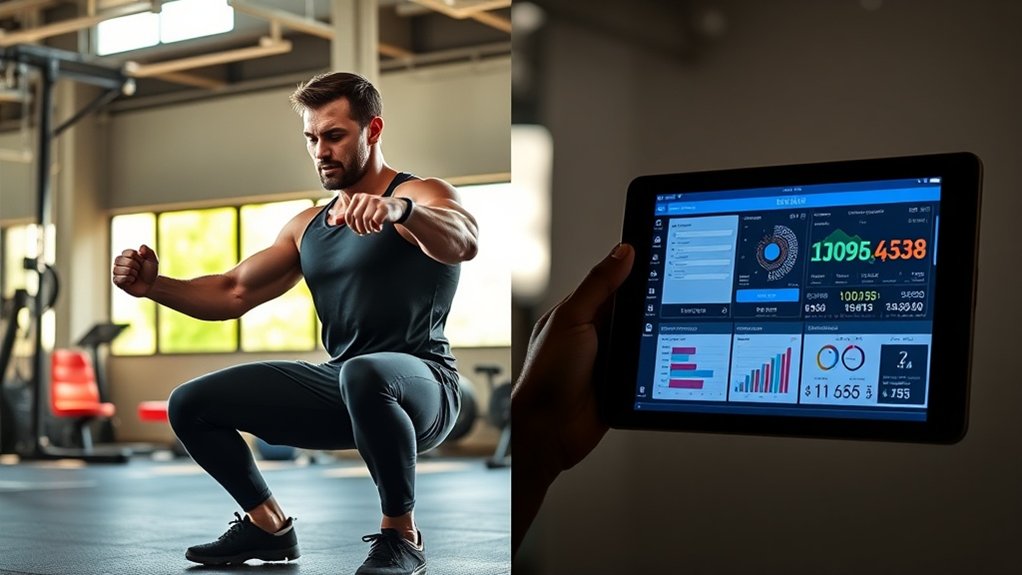
When choosing between AI coaches and human personal trainers, you’re deciding between two fundamentally different approaches to fitness boostment. AI coaches use data from millions of logged workouts to customize routines with algorithmic precision, while personal trainers apply experiential knowledge and intuition to your training needs.
Key differentiators include:
- Progress tracking: Fitness apps analyze real-time performance metrics and adjust your workout immediately, whereas human trainers modify plans between sessions.
- Cost structure: AI coaches provide personalized guidance at a fraction of traditional personal trainer fees, democratizing access to tailored programming.
- Motivation delivery: Human trainers excel at emotional support and accountability through interpersonal connection, which AI coaches can’t replicate despite superior data processing.
Your best choice depends on whether you prioritize data-driven increasement or human emotional intelligence in achieving fitness goals.
Data Privacy and Security in AI Fitness Applications: What Users Need to Know
Beyond selecting the right coaching approach, you’ll need to understand how AI fitness platforms handle your sensitive health information.
These AI fitness apps collect age, weight, gender, and workout preferences to generate personalized workout plans, making data privacy critical. Security measures vary greatly between platforms—not all offer robust encryption standards.
Data collection practices fall under regulations like GDPR and CCPA, requiring apps to obtain consent and transparently disclose how they process your information. You should regularly review privacy policies to understand your rights regarding data access, sharing, and deletion.
Reputable platforms provide options to anonymize data or delete accounts entirely. Choose applications with proven security credentials and clear consent mechanisms.
This proactive approach guarantees you maintain control over your personal health data while benefiting from AI-driven fitness technology.
Evaluating AI Training Tools: Key Criteria for Choosing the Right Platform
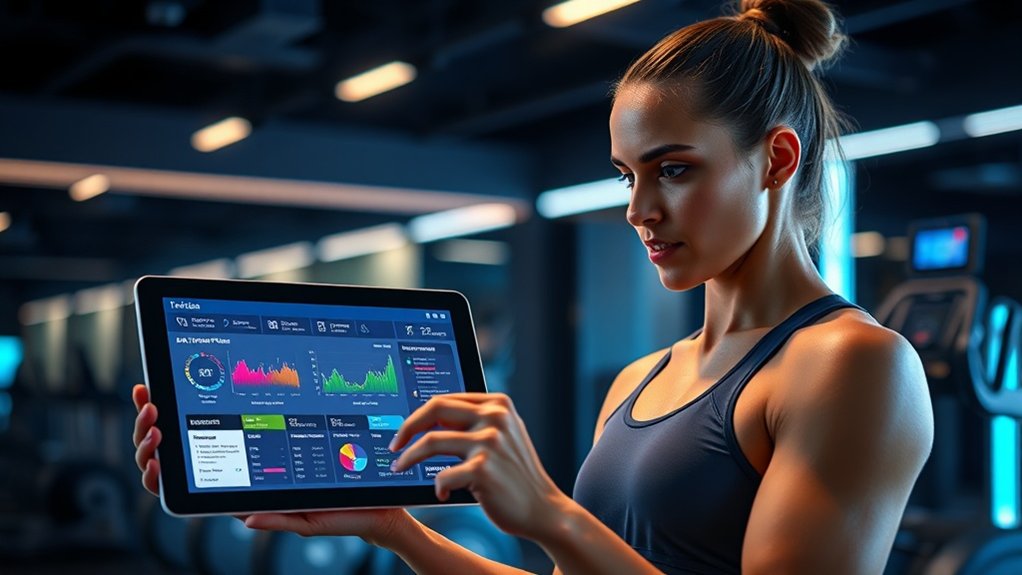
How do you determine which AI fitness platform delivers genuine value versus sophisticated marketing? Focus on measurable criteria that directly impact your effective workout outcomes.
Essential evaluation factors include:
- Personalization capabilities: The platform must analyze your fitness levels, available equipment, and performance data to generate tailored programming—not generic templates.
- Progress tracking features: Automatic logging systems provide quantifiable insights into your strength gains and performance metrics over time.
- Real-time adaptability: Advanced algorithms should modify intensity based on your immediate feedback and execution quality.
Examine the user interface for intuitive navigation that doesn’t hinder your training flow.
Platforms like Fitbod, Dr. Muscle, and Freeletics demonstrate these principles effectively.
Consider whether the community aspect improves accountability—though this remains secondary to algorithmic precision and data-driven programming.
Frequently Asked Questions
Can AI Create a Workout Plan for Me?
Yes, AI technology can create personalized fitness plans by analyzing your health metrics, training goals, and exercise preferences through data analysis. This approach maximizes workout efficiency, delivering evidence-based programming that adapts to your progress and specific needs.
What Is the 3-3-3 Rule for Workout?
The 3-3-3 rule structures your workout into three exercises, three sets each, delivering evidence-based benefits: ideal workout intensity, effective training through exercise variety, sustainable habits via manageable volume, and clear goal setting that supports your fitness progression systematically.
How to Use AI to Create a Training Plan?
Coincidentally, you’re analyzing AI just as fitness technology peaks. Input your fitness level assessment and training goals alignment into AI platforms. They’ll deliver adaptive workout adjustments, progress tracking tools, and nutrition integration features while incorporating your feedback for ideal AI customization benefits.
Can You Use Chatgpt to Create a Workout Plan?
Yes, you can use ChatGPT fitness tools to create personalized routines based on your workout goals and exercise preferences. However, you’ll need separate apps for nutrition integration, progress tracking, and injury prevention monitoring to guarantee thorough training support.

